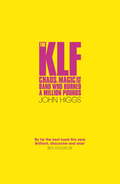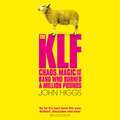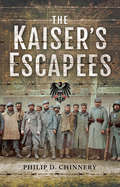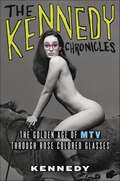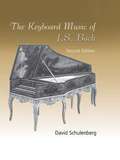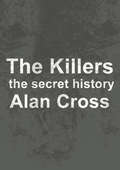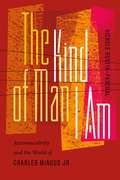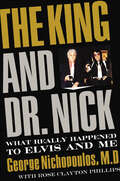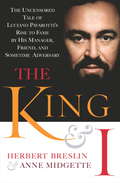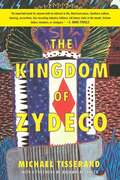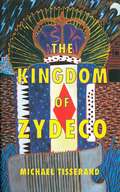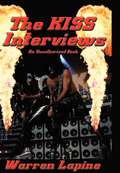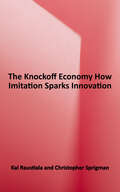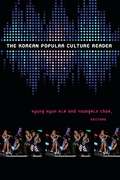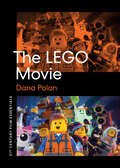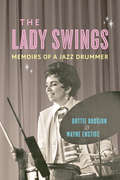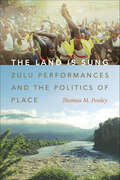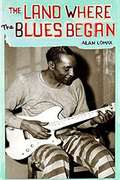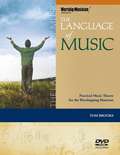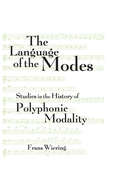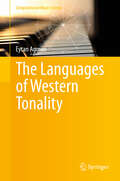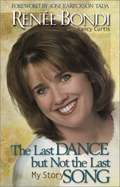- Table View
- List View
The KLF: Chaos, Magic and the Band who Burned a Million Pounds
by John Higgs'By far the best book this year, brilliant, discursive and wise' BEN GOLDACRE. The strange tale of the death, life and legacy of the hugely successful band.They were the bestselling singles band in the world. They had awards, credibility, commercial success and creative freedom. Then they deleted their records, erased themselves from musical history and burnt their last million pounds in a boathouse on the Isle of Jura. And they couldn't say why.This is not just the story of The KLF. It is a book about Carl Jung, Alan Moore, Robert Anton Wilson, Ken Campbell, Dada, Situationism, Discordianism, magic, chaos, punk, rave, the alchemical symbolism of Doctor Who and the special power of the number 23.Wildly unauthorised and unlike any other music biography, THE KLF is a trawl through chaos on the trail of a beautiful, accidental mythology.
The KLF: Chaos, Magic and the Band who Burned a Million Pounds
by John HiggsThe strange tale of the death, life and legacy of the hugely successful band.They were the bestselling singles band in the world. They had awards, credibility, commercial success and creative freedom. Then they deleted their records, erased themselves from musical history and burnt their last million pounds in a boathouse on the Isle of Jura. And they couldn't say why.This is not just the story of The KLF. It is a book about Carl Jung, Alan Moore, Robert Anton Wilson, Ken Campbell, Dada, Situationism, Discordianism, magic, chaos, punk, rave, the alchemical symbolism of Doctor Who and the special power of the number 23.Wildly unauthorised and unlike any other music biography, THE KLF is a trawl through chaos on the trail of a beautiful, accidental mythology.Read by John Higgs(p) Orion Publishing Group 2018
The Kaiser's Escapees: Allied POW escape attempts during the First World War
by Philip D. ChinneryFollowing on from the his first well-received book 'The Kaisers First POWs' Philip Chinnery now turns his attention to the attempts by allied prisoners of war to escape the Kaiser's clutches and return to their homeland. As the war progressed, the treatment of allied prisoners worsened as the blockade of Germany reduced the amount of food and material coming into the country. The majority of the prisoners were too weak or ill-equipped to attempt to escape, but there were others who were determined to pit their wits against their jailers. These included the officers at Holzminden prison, who dug a tunnel allowing twenty-eight of their number to escape; men like Canadian Private Simmons, who escaped and was recaptured twice before his third attempt saw him gain his freedom; men who jumped from moving trains or marched brazenly out of the camp gates disguised as German officers.Although Holland and Switzerland were neutral countries during the First World War, escaping from their camps, crossing miles of enemy territory and outwitting the sentries guarding the frontiers taxed even the strongest individuals. But many men did make the attempt and more than a few of them were successful. This is their story.
The Kennedy Chronicles: The Golden Age of MTV Through Rose Colored Glasses
by KennedyKennedy's off-the-wall memoir reliving the pop music and the madness as an MTV VJ in the 1990s"I am Kennedy from MTV, and no matter where I go someone has a story to tell me about the time we grew up together."Known to millions simply by her middle name, Kennedy helped bring the cutting edge of culture into our living rooms during the 1990s through her outrageous segments as an MTV VJ, host of Alternative Nation, and on-the-spot correspondent for MTV News. She interviewed everyone from fame-averse Seattle rock musicians to vapid celebrities and politicians, asking the taboo questions no one else would as she navigated between true artists and phony poseurs. In The Kennedy Chronicles, she gives us a backstage pass at the last golden years of the cable network that defined a generation.As only Kennedy can, she takes us back to unforgettable moments such as Nirvana's seminal performance on MTV Unplugged, the unbridled bacchanalia of the MTV Beach House and Woodstock '94 festival, and the game-changing "Rock the Vote" campaign. We read of priceless moments—on and off set—with such performers as Bjork, Pearl Jam, Weezer, No Doubt, Nine Inch Nails, Radiohead, Oasis, and the Red Hot Chili Peppers. And Kennedy dishes on behind-the-scenes antics with MTV colleagues including Jon Stewart, Bill Bellamy, Kurt Loder, and Tabitha Soren. Straddling the line between witness and participant, Kennedy recounts a blitz of surreal encounters: Dragging Stewart to a strip club. Getting naked with Jenny McCarthy. Playing dice on the men's room floor with Michael Jordan. Wrestling with Trent Reznor. Taking "Puck" Rainey from The Real World to church—and living to regret it. Making out in a coffin with Dave Navarro. Dodging calls from Courtney Love. Serving as John Rzeznik's muse for the Goo Goo Dolls hit song "Name." And there was that…incident…with New York Mayor Rudy Giuliani at the Video Music Awards. Finally, Kennedy intersperses her riotous narrative with priceless, candid interviews with Navarro, Henry Rollins, Billy Corgan, Pat Smear of Nirvana, Matt Cameron of Soundgarden and Pearl Jam, former VJ John Sencio, and more. In her characteristically edgy and irreverent voice, Kennedy delivers a juicy and revealing narrative perfect for Gen X and beyond—and for anyone who wants to know what really went on at MTV.
The Key to My Heart
by Lia Louis'Lia Louis has become a must-buy author for me!' JODI PICOULT'Heartwarming, hope-filled and hilarious' LINDSEY KELK Can you ever really find the one after 'the one'?Some people spend their whole lives trying to find the one. But Natalie had found him - and married him. And then Russ died.Two years ago, her whole world was shattered. Still now, she feels like she's trying to piece her broken heart back together, one day at a time.But then she finds a sheet of music - one that only Russ would know - in the piano stool in St. Pancras station where she's secretly been playing for the last few months.For the first time, Natalie realizes that maybe life does still hold a little magic. And with every note she plays, she feels as if she's unlocking another fragment of her heart...But will she ever truly find love again after she'd already found forever?
The Keyboard Music of J.S. Bach
by David SchulenbergThe Keyboard Music of J.S. Bach provides an introduction to and comprehensive discussion of all the music for harpsichord and other stringed keyboard instruments by Johann Sebastian Bach (1685-1750). Often played today on the modern piano, these works are central not only to the Western concert repertory but to musical pedagogy and study throughout the world.Intended as both a practical guide and an interpretive study, the book consists of three introductory chapters on general matters of historical context, style, and performance practice, followed by fifteen chapters on the individual works, treated in roughly chronological order. The works discussed include all of Bach's individual keyboard compositions as well as those comprising his famous collections, such as the Well-Tempered Clavier, the English and French Suites, and the Art of Fugue.
The Keys
by Dj KhaledFrom Snapchat sensation, business mogul, and recording artist DJ Khaled, the book They don't want you to read reveals his major keys to success. - Stay away from They- Don't ever play yourself- Secure the bag- Respect the code- Glorify your success- Don't deny the heat- Keep two rooms cooking at the same time - Win, win, win no matter whatFrom the Hardcover edition.
The Killers: The Secret History (The\secret History Of Rock Ser.)
by Alan CrossAlan Cross is the preeminent chronicler of popular music.Here he provides a history of Las Vegas rock band The Killers.This look at "one of the biggest new bands of the new century" is adapted from the audiobook.
The Kind of Man I Am: Jazzmasculinity and the World of Charles Mingus Jr. (Music-culture Ser.)
by Nichole Rustin-PaschalNearly four decades after his death, Charles Mingus Jr. remains one of the least understood and most recognized jazz composers and musicians of our time. Mingus’s ideas about music, racial identity, and masculinity—as well as those of other individuals in his circle, like Celia Mingus, Hazel Scott, and Joni Mitchell—challenged jazz itself as a model of freedom, inclusion, creativity, and emotional expressivity. Drawing on archival records, published memoirs, and previously conducted interviews, The Kind of Man I Am uses Mingus as a lens through which to craft a gendered cultural history of postwar jazz culture. This book challenges the persisting narrative of Mingus as jazz’s “Angry Man” by examining the ways the language of emotion has been used in jazz as shorthand for competing ideas about masculinity, authenticity, performance, and authority.
The King and Dr. Nick: What Really Happened to Elvis and Me
by George Nichopoulos Rose Clayton PhillipsThe truth about Elvis’s death from the doctor who spent eleven years as “the King’s” personal physician, father-figure, and confidant - "Dr. Nick."Dr. Nichopoulos spent a decade with Elvis on the road and at Graceland, trying to maintain the precarious health of one of the world’s greatest entertainers. But on August 16, 1977, he found himself in the ambulance with Elvis on that fateful last trip to the ER. He signed the death certificate.From that day forward, Dr. Nick became the focus of a media witch hunt that threatened his life and all but destroyed his professional reputation. Now, for the first time, Dr. Nick reveals the true story behind Elvis’s drug use and final days—not the version formed by years of tabloid journalism and gross speculation. Put aside what you’ve learned about Elvis’s final days and get ready to understand for the first time the inner workings of “the king of rock n’ roll.”
The King and I
by Anne Midgette Herbert BreslinLuciano Pavarotti's longtime manager and friend tells all. All.The King and I is the story of the thirty-six-year-old business relationship between Luciano Pavarotti and his manager, Herbert Breslin, during which Breslin guided what he calls, justifiably, "the greatest career in classical music." During that career, Breslin moved Pavarotti out of the opera house and onto the concert (and the world) stage and into the arms of a huge mass public. How he and Pavarotti changed the landscape of opera is one of the most significant and entertaining stories in the history of classical music, and Herbert Breslin relates the tale in a brash, candid, witty fashion that is often bitingly frank and profane. He also provides a portrait of his friend and client--"a beautiful, simple, lovely guy who turned into a very determined, aggressive, and somewhat unhappy superstar"--that is by turns affectionate and satirical and full of hilarious details and tales out of school, with Pavarotti emerging as something like the ultimate Italian male. The book is also enlivened by the voices of other players in the soap opera drama that was Pavarotti's career, and they are no less uncensored than Herbert Breslin. The last word, in fact, comes from none other than Luciano Pavarotti himself!The King and I is the ultimate backstage book about the greatest opera star of the past century--and it's a delight to read as well.
The Kingdom Of Swing
by Irving Kolodin Benny Goodmanthe book deals with the life of Benny Goodman up to the year 1939. Since he lived 37 years after this publishing, it is only partly the story of his life.
The Kingdom of Zydeco
by Michael Tisserand Buckwheat Zydeco"An important book for anyone with an interest in life, American music, Southern culture, dancing, accordions, the recording industry, folklore, old dance clubs in the weeds, fortune tellers, hoodoos or shotguns." -Annie ProulxThere's a musical kingdom in the American South that's not marked on any map. Stretching from the prairies of Louisiana to the oil towns of East Texas, it is ruled over accordion-squeezing, washboard-wielding musicians such as Buckwheat Zydeco, Nathan Williams, Keith Frank, Terrance Simien, Rosie Ledet, and C. J. Chenier. Theirs is the kingdom of zydeco. With its African-Caribbean rhythms, Creole-French-English lyrics, and lively dance styles, zydeco has spread from its origins in Louisiana across the nation, from Back Bay to the Bay Area. It has influenced the music of Eric Clapton and Paul Simon and been played at Carnegie Hall.In this remarkable and engrossing book, Michael Tisserand reveals why zydeco's identifiable and unforgettable blend of blues and Cajun influences has made the dance music of Louisiana black Creoles so popular and widespread. Zydeco's appeal runs deeper than the feel-good, get-up-and-dance reaction it invariably elicits and is intertwined in the music's roots and rhythms, handed down from generation to generation. Here is the story of zydeco music. Tisserand goes on the zydeco trail to meet the major artists; he reconstructs the legends behind the music's beginnings, offering complete biographies of pioneers such as Amédé Ardoin and Clifton Chenier; and he takes you into the dance halls and onto the front porches where zydeco was born and continues to thrive. More than a book on a musical style, The Kingdom of Zydeco is an exploration and a celebration of a distinctive American culture.
The Kingdom of Zydeco
by Michael TisserandStretching from the bayous of Louisiana to the oil towns of East Texas, the kingdom of zydeco is ruled by accordion-playing, washboard-wielding kings and queens named Beau Jocque, Boozoo Chavis, Queen Ida and-the King of Zydeco himself-Clifton Chenier. In this book, the leading expert on zydeco music provides the ultimate guide to this red-hot music and its origins.
The Kiss Interviews
by Warren LapineCollected here for the first time are sixteen interviews and articles with and about the hottest band in the world: KISS. Warren Lapine is an experienced interviewer and a long time KISS fan. This book is just what the doctor ordered for the hard core KISS fan. These interviews are insightful and intelligent, Lapine asks Paul Stanley and Gene Simmons the questions that KISS fans want to have answered.
The Knockoff Economy: How Imitation Sparks Innovation
by Kal Raustiala Christopher SprigmanFrom the shopping mall to the corner bistro, knockoffs are everywhere in today's marketplace. Conventional wisdom holds that copying kills creativity, and that laws that protect against copies are essential to innovation--and economic success. But are copyrights and patents always necessary? In The Knockoff Economy, Kal Raustiala and Christopher Sprigman provocatively argue that creativity can not only survive in the face of copying but can thrive. The Knockoff Economy approaches the question of incentives and innovation in a wholly new way--by exploring creative fields where copying is generally legal, such as fashion, food, and even professional football. <p><p>By uncovering these important but rarely studied industries, Raustiala and Sprigman reveal a nuanced and fascinating relationship between imitation and innovation. In some creative fields, copying is kept in check through informal industry norms enforced by private sanctions. In others, the freedom to copy actually promotes creativity. High fashion gave rise to the very term "knockoff," yet the freedom to imitate great designs only makes the fashion cycle run faster--and forces the fashion industry to be even more creative. Raustiala and Sprigman carry their analysis from food to font design to football plays to finance, examining how and why each of these vibrant industries remains innovative even when imitation is common. There is an important thread that ties all these instances together--successful creative industries can evolve to the point where they become inoculated against--and even profit from--a world of free and easy copying. And there are important lessons here for copyright-focused industries, like music and film, that have struggled as digital technologies have made copying increasingly widespread and difficult to stop. <p><p>Raustiala and Sprigman's arguments have been making headlines in The New Yorker, the New York Times, the Financial Times, the Boston Globe, Le Monde, and at the Freakonomics blog, where they are regular contributors. By looking where few had looked before--at markets that fall outside normal IP law--The Knockoff Economy opens up fascinating creative worlds. And it demonstrates that not only is a great deal of innovation possible without intellectual property, but that intellectual property's absence is sometimes better for innovation.
The Korean Popular Culture Reader
by Kyung Hyun Kim Youngmin ChoeOver the past decade, Korean popular culture has become a global phenomenon. The "Korean Wave" of music, film, television, sports, and cuisine generates significant revenues and cultural pride in South Korea. The Korean Popular Culture Reader provides a timely and essential foundation for the study of "K-pop," relating the contemporary cultural landscape to its historical roots. The essays in this collection reveal the intimate connections of Korean popular culture, or hallyu, to the peninsula's colonial and postcolonial histories, to the nationalist projects of the military dictatorship, and to the neoliberalism of twenty-first-century South Korea. Combining translations of seminal essays by Korean scholars on topics ranging from sports to colonial-era serial fiction with new work by scholars based in fields including literary studies, film and media studies, ethnomusicology, and art history, this collection expertly navigates the social and political dynamics that have shaped Korean cultural production over the past century.Contributors. Jung-hwan Cheon, Michelle Cho, Youngmin Choe, Steven Chung, Katarzyna J. Cwiertka, Stephen Epstein, Olga Fedorenko, Kelly Y. Jeong, Rachael Miyung Joo, Inkyu Kang, Kyu Hyun Kim, Kyung Hyun Kim, Pil Ho Kim, Boduerae Kwon, Regina Yung Lee, Sohl Lee, Jessica Likens, Roald Maliangkay, Youngju Ryu, Hyunjoon Shin, Min-Jung Son, James Turnbull, Travis Workman
The LEGO Movie (21st Century Film Essentials)
by Dana PolanWhat happens when we set out to understand LEGO not just as a physical object but as an idea, an icon of modernity, an image—maybe even a moving image? To what extent can the LEGO brick fit into the multimedia landscape of popular culture, especially film culture, today? Launching from these questions, Dana Polan traces LEGO from thing to film and asserts that The LEGO Movie is an exemplar of key directions in mainstream cinema, combining the visceral impact of effects and spectacle with ironic self-awareness and savvy critique of mass culture as it reaches for new heights of creativity. Incorporating insights from conversations with producer Dan Lin and writer-directors Phil Lord and Chris Miller, Polan examines the production and reception of The LEGO Movie and closely analyzes the film within popular culture at large and in relation to LEGO as a toy and commodity. He identifies the film&’s particular stylistic and narrative qualities, its grasp of and response to the culture industry, and what makes it a distinctive work of animation within the seeming omnipresence of animation in Hollywood, and reveals why the blockbuster film, in all its silliness and seriousness, stands apart as a divergent cultural work.
The Lady Swings: Memoirs of a Jazz Drummer (Music in American Life #543)
by Wayne Enstice Dottie DodgionDottie Dodgion is a jazz drummer who played with the best. A survivor, she lived an entire lifetime before she was seventeen. Undeterred by hardships she defied the odds and earned a seat as a woman in the exclusive men’s club of jazz. Her dues-paying path as a musician took her from early work with Charles Mingus to being hired by Benny Goodman at Basin Street East on her first day in New York. From there she broke new ground as a woman who played a “man’s instrument” in first-string, all-male New York City jazz bands. Her inspiring memoir talks frankly about her music and the challenges she faced, and shines a light into the jazz world of the 1960s and 1970s. Vivid and always entertaining, The Lady Swings tells Dottie Dodgion's story with the same verve and straight-ahead honesty that powered her playing.
The Land Is Sung: Zulu Performances and the Politics of Place
by Thomas M. PooleyWhat does it mean to belong? In The Land is Sung, musicologist Thomas M. Pooley shows how performances of song, dance, and praise poetry connect Zulu communities to their ancestral homes and genealogies. For those without land tenure in the province of KwaZulu-Nata, performances articulate a sense of place. Migrants express their allegiances through performance and spiritual relationships to land are embodied in rituals that invoke ancestral connection while advancing well-being through intergenerational communication. Engaging with justice and environmental ethics, education and indigenous knowledge systems, musical and linguistic analysis, and the ethics of recording practice, Pooley's analysis draws on genres of music and dance recorded in the midlands and borderlands of South Africa, and in Johannesburg's inner city. His detailed sound writing captures the visceral experiences of performances in everyday life. The book is richly illustrated and there is a companion website featuring both video and audio examples.
The Land Where The Blues Began
by Alan LomaxA self-described "song-hunter" the folklorist Alan Lomax traveled the Mississippi Delta in the 1930s and 40s armed with primitive recording equipment and a keen love of the Delta's music heritage. Crisscrossing the towns and hamlets where the blues began, Lomax gave voice to such greats as Leadbelly, Fred MacDowell, Muddy Waters, and many others, all of whom made their debut recordings with him.
The Language of Music: Practical Music Theory for the Worshipping Musician (Worship Musician Presents Series)
by Tom BrooksIn The Language of Music, Tom Brooks demystifies and explains the basic building blocks of music in a simple, clear, straightforward way – essential knowledge that every worship musician needs to perfect his craft. The book offers a practical, real-world approach to all the fundamental concepts; music theory and harmony, chord construction, scales, key signatures, chord relationships, transposition, modulation, chart reading, and basic arranging, along with tips on how to practice more efficiently and rehearse more effectively, and much more. The focus is on contemporary praise and worship; music that is inspiring the church in the 21st century.
The Language of the Modes: Studies in the History of Polyphonic Modality (Criticism And Analysis Of Early Music Ser.)
by Frans WieringThe Language of the Modes provides a study of modes in early music through eight essays, each dealing with a different aspects of modality. The volume codifies all known theoretical references to mode, all modally ordered musical sources, and all modally cyclic compositions. For many music students and listeners, the "language of the modes" is a deep mystery, accustomed as we are to centuries of modern harmony. Wiering demystifies the modal world, showing how composers and performers were able to use this structure to create compelling and beautiful works. This book will be an invaluable source to scholars of early music and music theory. in early music through eight essays, each dealing with a different aspects of modality. It codifies all known theoretical references to mode, all modally ordered musical sources, and all modally cyclic compositions. This book will be an invaluable source to scholars of early music.
The Languages of Western Tonality
by Eytan AgmonTonal music, from a historical perspective, is far from homogenous; yet an enduring feature is a background "diatonic" system of exactly seven notes orderable cyclically by fifth. What is the source of the durability of the diatonic system, the octave of which is representable in terms of two particular integers, namely 12 and 7? And how is this durability consistent with the equally remarkable variety of musical styles -- or languages -- that the history of Western tonal music has taught us exist? This book is an attempt to answer these questions. Using mathematical tools to describe and explain the Western musical system as a highly sophisticated communication system, this theoretical, historical, and cognitive study is unprecedented in scope and depth. The author engages in intense dialogue with 1000 years of music-theoretical thinking, offering answers to some of the most enduring questions concerning Western tonality. The book is divided into two main parts, both governed by the communicative premise. Part I studies proto-tonality, the background system of notes prior to the selection of a privileged note known as "final. " After some preliminaries that concern consonance and chromaticism, Part II begins with the notion "mode. " A mode is "dyadic" or "triadic," depending on its "nucleus. " Further, a "key" is a special type of "semi-key" which is a special type of mode. Different combinations of these categories account for tonal variety. Ninth-century music, for example, is a tonal language of dyadic modes, while seventeenth-century music is a language of triadic semi-keys. While portions of the book are characterized by abstraction and formal rigor, more suitable for expert readers, it will also be of value to anyone intrigued by the tonal phenomenon at large, including music theorists, musicologists, and music-cognition researchers. The content is supported by a general index, a list of definitions, a list of notation used, and two appendices providing the basic mathematical background.
The Last Dance But Not the Last Song: My Story
by Renee BondiRenee had it all... a dream job teaching high school choir and a wedding to plan for. life was good until a freak accident left her parilized from the shoulders down. inspiring story of faith and triumph
